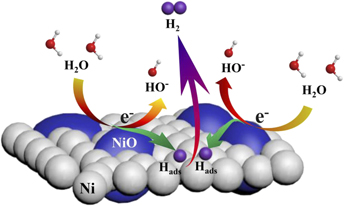Crossref Citations
This article has been cited by the following publications. This list is generated based on data provided by
Crossref.
Wu, Zhen
Zhu, Luying
Yang, Fusheng
Nyamsi, Serge N.
Porpatham, Ekambaram
and
Zhang, Zaoxiao
2018.
Toward the design of interstitial nonmetals co-doping for Mg-based hydrides as hydrogen storage material.
Journal of Materials Research,
Vol. 33,
Issue. 23,
p.
4080.
Huan, Yahuan
Shi, Jianping
Zhao, Guanchao
Yan, Xiaoqin
and
Zhang, Yanfeng
2019.
2D Metallic Transitional Metal Dichalcogenides for Electrochemical Hydrogen Evolution.
Energy Technology,
Vol. 7,
Issue. 8,
Patil, Rituja B.
Mantri, Aayush
House, Stephen D.
Yang, Judith C.
and
McKone, James R.
2019.
Enhancing the Performance of Ni-Mo Alkaline Hydrogen Evolution Electrocatalysts with Carbon Supports.
ACS Applied Energy Materials,
Vol. 2,
Issue. 4,
p.
2524.
Huang, Xieyi
Wang, Peng
Zhang, Zhichao
Zhang, Shaoning
Du, Xianlong
Bi, Qingyuan
and
Huang, Fuqiang
2019.
Efficient conversion of CO2 to methane using thin-layer SiOx matrix anchored nickel catalysts.
New Journal of Chemistry,
Vol. 43,
Issue. 33,
p.
13217.
Wang, Min
Zhao, Rupeng
Li, Xingyun
Zhao, Xiusong
and
Jiang, Luhua
2019.
Three‐Dimensional Assembly of Iron Phosphide Nanosheets: Synthesis and Enhanced Catalytic Activity for Hydrogen Evolution Reaction.
ChemNanoMat,
Vol. 5,
Issue. 5,
p.
593.
Peng, Lishan
Zheng, Xingqun
Li, Li
Zhang, Ling
Yang, Na
Xiong, Kun
Chen, Hongmei
Li, Jing
and
Wei, Zidong
2019.
Chimney effect of the interface in metal oxide/metal composite catalysts on the hydrogen evolution reaction.
Applied Catalysis B: Environmental,
Vol. 245,
Issue. ,
p.
122.
Chen, Yuerong
and
Jin, Huiming
2020.
Fabrication of amorphous Co–Cr–B and catalytic sodium borohydride hydrolysis for hydrogen generation.
Journal of Materials Research,
Vol. 35,
Issue. 3,
p.
281.
Márquez-Montes, Raúl A.
Kawashima, Kenta
Vo, Kobe M.
Chávez-Flores, David
Collins-Martínez, Virginia H.
Mullins, C. Buddie
and
Ramos-Sánchez, Víctor H.
2020.
Simultaneous Sulfite Electrolysis and Hydrogen Production Using Ni Foam-Based Three-Dimensional Electrodes.
Environmental Science & Technology,
Vol. 54,
Issue. 19,
p.
12511.
Sarno, M.
Ponticorvo, E.
and
Scarpa, D.
2020.
Novel Pt-Ni/NiO/Ni2O3 based electrodes for electrocatalytic biodiesel production from waste palm oil.
Materials Today: Proceedings,
Vol. 20,
Issue. ,
p.
69.
Shi, Jinghui
Qiu, Fen
Yuan, Wenbo
Guo, Manman
Yuan, Cailei
and
Lu, Zhang-Hui
2020.
Novel electrocatalyst of nanoporous FeP cubes prepared by fast electrodeposition coupling with acid-etching for efficient hydrogen evolution.
Electrochimica Acta,
Vol. 329,
Issue. ,
p.
135185.
Im, Sang Won
Ahn, Hehsang
Seo, Da Hye
Park, Sunghak
Choi, Seungwoo
Ryu, Wookha
Kim, Kyungjun
Park, Eun Soo
and
Nam, Ki Tae
2020.
A scalable Al–Ni alloy powder catalyst prepared by metallurgical microstructure control.
Journal of Materials Chemistry A,
Vol. 8,
Issue. 22,
p.
11133.
Bao, Yunkai
Dai, Jianying
Zhao, Jun
Wu, Yun
Li, Chuan
Ji, Lifei
Zhang, Xin
and
Yang, Fengchun
2020.
Modulation in Ruthenium–Cobalt Electronic Structure for Highly Efficient Overall Water Splitting.
ACS Applied Energy Materials,
Vol. 3,
Issue. 2,
p.
1869.
Natarajan, Kaushik
Saraf, Mohit
Gupta, Anoop K.
and
Mobin, Shaikh M.
2020.
Nanostructured δ-MnO2/Cd(OH)2 Heterojunction Constructed under Ambient Conditions as a Sustainable Cathode for Photocatalytic Hydrogen Production.
Industrial & Engineering Chemistry Research,
Vol. 59,
Issue. 16,
p.
7584.
Kawashima, Kenta
Márquez-Montes, Raúl A.
Li, Hao
Shin, Kihyun
Cao, Chi L.
Vo, Kobe M.
Son, Yoon Jun
Wygant, Bryan R.
Chunangad, Adithya
Youn, Duck Hyun
Henkelman, Graeme
Ramos-Sánchez, Víctor H.
and
Mullins, C. Buddie
2021.
Electrochemical behavior of a Ni3N OER precatalyst in Fe-purified alkaline media: the impact of self-oxidation and Fe incorporation.
Materials Advances,
Vol. 2,
Issue. 7,
p.
2299.
Baibars, Ibrahem O.
Abd El-Moghny, Muhammad G.
Mogoda, Awad S.
and
El-Deab, Mohamed S.
2021.
Microporous Film of Ternary Ni/Co/Fe Alloy for Superior Electrolytic Hydrogen Production in Alkaline Medium.
Journal of The Electrochemical Society,
Vol. 168,
Issue. 5,
p.
054509.
Xie, Yang-Yang
Chen, Hui-Jun
Bai, Qi-Yao
Wang, Xiu-Li
Wu, Gang
Chen, Si-Chong
and
Wang, Yu-Zhong
2021.
NiO nanofibers clad nickel foam as binder-free electrode with ultrahigh mass loading: boosting performance of hybrid supercapacitor and overall water-splitting.
Electrochimica Acta,
Vol. 390,
Issue. ,
p.
138772.
Duraivel, Malarkodi
Nagappan, Saravanan
Park, Kang Hyun
and
Prabakar, Kandasamy
2022.
Hierarchical 3D flower like cobalt hydroxide as an efficient bifunctional electrocatalyst for water splitting.
Electrochimica Acta,
Vol. 411,
Issue. ,
p.
140071.
Duraivel, Malarkodi
Nagappan, Saravanan
Park, Kang Hyun
Ha, Chang-Sik
and
Prabakar, Kandasamy
2022.
Transition metal oxy/hydroxides functionalized flexible halloysite nanotubes for hydrogen evolution reaction.
Journal of Colloid and Interface Science,
Vol. 618,
Issue. ,
p.
518.
Paksoy, Aybike
Kurtoğlu-Öztulum, Samira F.
Yağcı, M. Barış
and
Balcı-Çağıran, Özge
2022.
Low-cost and reusable iron- and nickel-based metal boride nanoparticles for efficient catalytic hydrolysis of sodium borohydride.
International Journal of Hydrogen Energy,
Vol. 47,
Issue. 87,
p.
36898.
Do, Ha Huu
Nguyen, Thi Hong Chuong
Nguyen, Tuan Van
Xia, Changlei
Nguyen, Dang Le Tri
Raizada, Pankaj
Singh, Pardeep
Nguyen, Van-Huy
Ahn, Sang Hyun
Kim, Soo Young
and
Le, Quyet Van
2022.
Metal-organic-framework based catalyst for hydrogen production: Progress and perspectives.
International Journal of Hydrogen Energy,
Vol. 47,
Issue. 88,
p.
37552.




